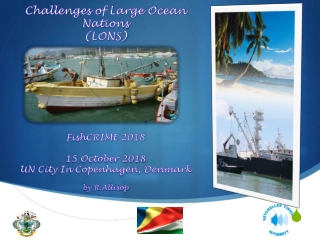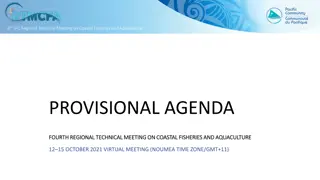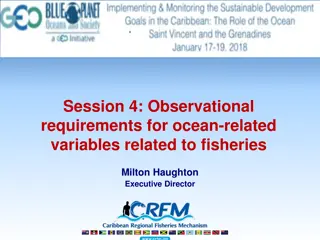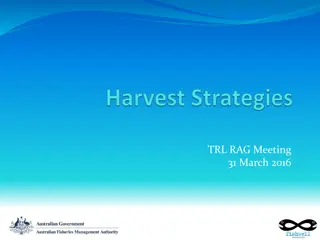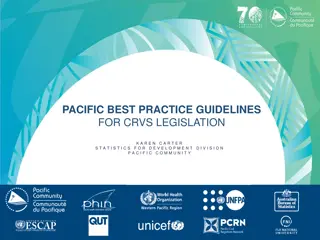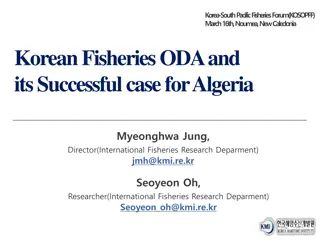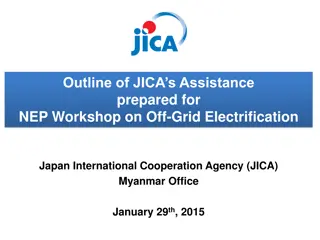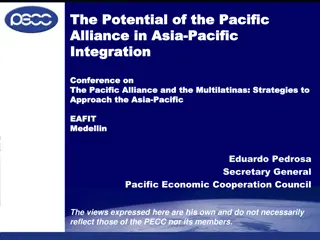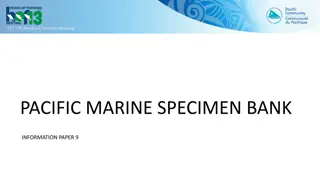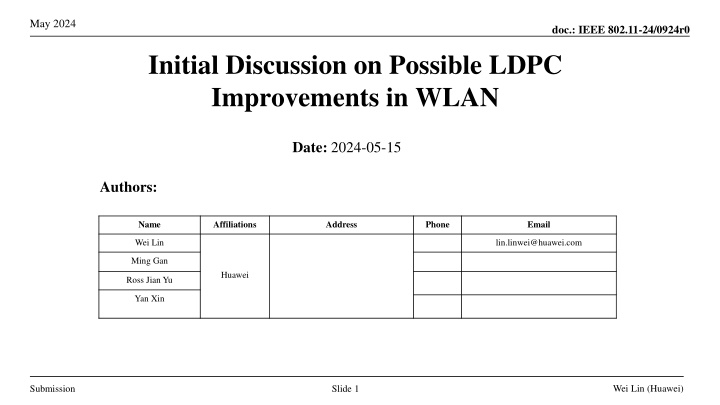
JICA Fisheries Assistance Strategy and Pacific Fisheries Initiatives
The Sixth Pacific Island Leaders Meeting in Okinawa emphasized the importance of sustainable fisheries management and enhancing cooperation for economic growth. Japan's JICA is providing fisheries-related development cooperation in the Pacific region, focusing on stable food supply, malnutrition elimination, and poverty reduction through supporting local fishing communities and appropriate resource management.
Download Presentation

Please find below an Image/Link to download the presentation.
The content on the website is provided AS IS for your information and personal use only. It may not be sold, licensed, or shared on other websites without obtaining consent from the author. If you encounter any issues during the download, it is possible that the publisher has removed the file from their server.
You are allowed to download the files provided on this website for personal or commercial use, subject to the condition that they are used lawfully. All files are the property of their respective owners.
The content on the website is provided AS IS for your information and personal use only. It may not be sold, licensed, or shared on other websites without obtaining consent from the author.
E N D
Presentation Transcript
May 2024 doc.: IEEE 802.11-24/0924r0 Initial Discussion on Possible LDPC Improvements in WLAN Date: 2024-05-15 Authors: Name Affiliations Address Phone Email Wei Lin lin.linwei@huawei.com Ming Gan Huawei Ross Jian Yu Yan Xin Wei Lin (Huawei) Submission Slide 1
May 2024 doc.: IEEE 802.11-24/0924r0 Discussion on Current WLAN LDPC Codes The current 11n LDPC codes were designed and introduced for 802.11n in around 2004. There are 4 code rates (1/2, 2/3, 3/4, 5/6) and 3 code lengths (648, 1296, 1944) supported in Wi-Fi systems since then Highest Rate = 5/6, Longest Length = 1944 The 12 different LDPC matrices were designed individually for each rate and length, i.e., they don t share the same base matrix or set of permutation coefficients. Since the invention of 11n LDPC codes, multiple LDPC codes were introduced for various industrial scenarios, e.g., 5G NR, 11ad/ay, DVB, ATSC 3.0, PON, etc. Among the various industrial LDPC codes, 5G NR LDPC codes can support very large range of rates and lengths with 2 base matrices and 2 set of permutation coefficients. BG1 of size 46 x 68 can support rates of 1/3 R 8/9, and information lengths of 308 K 8448 BG2 of size 42 52 can support rates of 1/5 R 2/3, and information lengths of 40 K 3840 The 11n LDPC length of 1944 were designed for BW 40M, Streams 4, and Mod 64QAM In Wi-Fi 8, the highest throughput can be achieved with largest BW >= 320M, 8 spatial streams, 4096QAM, thus the number of LDPC codewords can be very large with current length-1944 LDPC Wei Lin (Huawei) Submission Slide 2
May 2024 doc.: IEEE 802.11-24/0924r0 11n LDPC vs. NR LDPC: Code Structures NR LDPC BG1: 1/3 R 8/9, 308 K 8448 NR LDPC BG2: 1/5 R 2/3, 40 K 3840 11n LDPC, Length = 1944, Z = 81 Wei Lin (Huawei) Submission Slide 3
May 2024 doc.: IEEE 802.11-24/0924r0 Industrial LDPC: Classic QC-LDPC There are currently two major LDPC structures widely employed in industry Classic QC-LDPC (11n/11ad/DVB) and Raptor-Like QC-LDPC (5G NR) Classic QC-LDPC (11n/11ad/DVB) Repeat Accumulate + Quasi Cyclic RA RA RA 11ad/ay LDPC Code Parity-Check Part of WLAN LDPC Codes DVB-S2 LDPC Code Classic QC-LDPC codes are widely employed in various standards, they are implementation friendly and good performance for fixed rates/lengths Classic QC-LDPC codes are not convenient for rate/length compatible, e.g., require a individually designed H matrix for each rate and length (12 matrices in 11n), and significant performance loss occurs for shortening or puncturing Wei Lin (Huawei) Submission Slide 4
May 2024 doc.: IEEE 802.11-24/0924r0 Industrial LDPC: Raptor-Like QC-LDPC Raptor-Like QC-LDPC Protograph + Multi-Edge Type + Accumulate Repeat Accumulate Degree-1 Nodes State Nodes Multi-Edge Type (MET) Accumulate Repeat Accumulate (ARA) Protograph Protograph: a Tanner graph with a relatively small number of nodes Protograph design & Lifting optimization P-EXIT chart analysis (Liva2007) different protographs having same degree distribution may have different thresholds The Protograph-based LDPC codes can be extended to long lengths through different lifting sizes with single base matrix decoding threshold can guarantee the performance Multi-Edge Type: edges are better controlled by categorizing into several different types Can avoid weak local combinations of nodes e.g., all connections to a particular CN being made to VNs of smallest degree ARA & MET: state nodes in conjunction with degree-1 nodes improve performance with controlled complexity Raptor-Like QC-LDPC codes can accommodate various rates and lengths with a single base matrix, and also can obtain very good performance under shortening and puncturing Wei Lin (Huawei) Submission Slide 5
May 2024 doc.: IEEE 802.11-24/0924r0 11n LDPC vs. NR LDPC: Performance NR LDPC codes are the most popular recent-designed LDPC codes in wireless domain, thus we compare the 11n LDPC with NR LDPC to have a perspective on the possible improvements Performances of 11n LDPC and NR LDPC are compared at longest 11n LDPC length N = 1944 and longest NR LDPC info. length k = 8448, respectively. Simulation settings: BPSK + AWGN, only 1944 LDPC considered for 11n LDPC Layered Normalized Min-Sum (Alpha = 0.75) Decoder with 8 iterations are employed The plotted SNRs are not adjusted to the true SNRs for PAM modulations (3dB smaller due to factor of 2) For each of the four 11n LDPC rates (1/2, 2/3, 3/4, 5/6), four curves are plotted for comparisons Curve 1: Rate-R 11n LDPC with k = 1944*R and single codeword Curve 2: Rate-R NR LDPC with k = 1944*R and single codeword, the BGs (BG1 or BG2) and lifting parameters (Z) are selected according to the code selection rule of 5G NR Curve 3: Rate-R 11n LDPC with k = 1944*R*Num 8448, and Num codewords Curve 4: Rate-R NR LDPC with k = 8448 (longest supported info. bits in a single codeword) and single codeword, the codeword length N = 8448/R. Wei Lin (Huawei) Submission Slide 6
May 2024 doc.: IEEE 802.11-24/0924r0 11n LDPC vs. NR LDPC: R = 1/2 For K = 972, N = 1944 11n LDPC code and NR LDPC code (BG2 with Z = 104), the NR LDPC outperforms 11n LDPC for around 0.6 dB at BLER = 10-3 For K = 8448, N = 16896 NR LDPC code (BG1 with Z = 384) and 9 codewords of 11n 1944 LDPC code, the NR LDPC outperforms 11n LDPC for around 1.2 dB at BLER = 10-3 The performance of 9 codewords of 11n 1944 LDPC code is obtained by scaling the performance of single codeword FER_Num = 1 (1 FER_1)Num Wei Lin (Huawei) Submission Slide 7
May 2024 doc.: IEEE 802.11-24/0924r0 11n LDPC vs. NR LDPC: R = 2/3 For K = 1296, N = 1944 11n LDPC code and NR LDPC code (BG2 with Z = 144), the NR LDPC performs similar to 11n LDPC at BLER = 10-3 For K = 8448, N = 12672 NR LDPC code (BG1 with Z = 384) and 7 codewords of 11n 1944 LDPC code, the NR LDPC outperforms 11n LDPC for around 0.5 dB at BLER = 10-3 The performance of 7 codewords of 11n 1944 LDPC code is obtained by scaling the performance of single codeword FER_Num = 1 (1 FER_1)Num Wei Lin (Huawei) Submission Slide 8
May 2024 doc.: IEEE 802.11-24/0924r0 11n LDPC vs. NR LDPC: R = 3/4 For K = 1458, N = 1944 11n LDPC code and NR LDPC code (BG1 with Z = 72), the NR LDPC outperforms 11n LDPC for around 0.25 dB at BLER = 10-3 For K = 8448, N = 11264 NR LDPC code (BG1 with Z = 384) and 6 codewords of 11n 1944 LDPC code, the NR LDPC outperforms 11n LDPC for around 0.5 dB at BLER = 10-3 The performance of 6 codewords of 11n 1944 LDPC code is obtained by scaling the performance of single codeword FER_Num = 1 (1 FER_1)Num Wei Lin (Huawei) Submission Slide 9
May 2024 doc.: IEEE 802.11-24/0924r0 11n LDPC vs. NR LDPC: R = 5/6 For K = 1620, N = 1944 11n LDPC code and NR LDPC code (BG1 with Z = 80), the NR LDPC outperforms 11n LDPC for around 0.45 dB at BLER = 10-3 For K = 8448, N = 10138 NR LDPC code (BG1 with Z = 384) and 6 codewords of 11n 1944 LDPC code, the NR LDPC outperforms 11n LDPC for around 0.7 dB at BLER = 10-3 The performance of 6 codewords of 11n 1944 LDPC code is obtained by scaling the performance of single codeword FER_Num = 1 (1 FER_1)Num Wei Lin (Huawei) Submission Slide 10
May 2024 doc.: IEEE 802.11-24/0924r0 Summary With the increase of codeword lengths, the NR LDPC outperforms the longest 11n LDPC at various code rates over 1 dB at rate-1/2 Coding gain of NR LDPC over 11n LDPC is largest for rate-1/2, and varies for different rates the main reason is that the longest NR LDPC keep the same info. bits of 8448, and the code length decrease with the increase of rate For longest NR LDPC, N = 16896 for R = 1/2, N = 12672 for R = 2/3, N = 11264 for R = 3/4, N = 10138 for R = 5/6 11be supports largest BW >= 320M, 8 spatial streams, 4096QAM, however, the highest rate of 11n LDPC is 5/6, while NR LDPC can support rate as high as 8/9 Wei Lin (Huawei) Submission Slide 11
May 2024 doc.: IEEE 802.11-24/0924r0 Thank You Wei Lin (Huawei) Submission Slide 12
May 2024 doc.: IEEE 802.11-24/0924r0 Appendix: SNR for real and complex signals Es/N0, Eb/N0 and SNR: Es/N0 = (Eb*R)/N0 Es/N0 and SNR: QPSK & QAMs BPSK & PAMs When Tsym = Tsamp, For complex signals (QPSK): Es/N0 = SNR For real signals (BPSK): Es/N0 = 0.5*SNR Source: Robert G. Gallager, Principles of Digital Communication Gallager, 2008 To in line with the industrial custom, our SNRs are actually Es/N0 for BPSK, and the real SNR of BPSK shall be 2*Es/N0 Wei Lin (Huawei) Submission Slide 13

